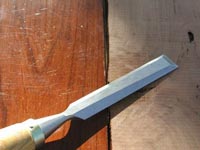Resource Library
Plant of the Week: Wild Black Cherry
The University of Arkansas System Division of Agriculture does not promote, support or recommend plants featured in "Plant of the Week." Please consult your local Extension office for plants suitable for your region.
Plant of the Week
Wild Black Cherry
Latin: Prunus serotina

Of late, I've become an arm-chair expert on the value of early American furniture, thanks to the education provided by the appraisers on PBS's Antiques Road Show. I personally find the simple, yet elegant designs produced in late 18th century New England cabinet shops most appealing. Much of that furniture was crafted from wild black cherry, my favorite wood for furniture building.
Wild Black Cherry (Prunus serotina) grows everywhere in the eastern woodlands from Minnesota to Texas and is common throughout Arkansas. It's the largest cherry, capable of reaching 100 feet with trunks as thick as 4 feet. Mostly though, we see 50- to 60-foot tall trees with oval to pyramidal forms and the tips of branches arching downward.
Black cherry leaves are 2 to 4 inches long, glossy green above and paler beneath. At the base of the leaf blade or on the petiole a prominent gland marks their membership to the cherry tree clan. Fall color is a subtle yellow to orange.
Wild black cherry leaves contain prunasin, a cyanide containing sugar molecule. It's relatively benign unless the leaves are exposed to some kind of stress such as drought, frost or wilting. Then, prunasin breaks down and releases cyanide. Cyanide makes it impossible for cells to get oxygen from the blood, with fatal results. Cattle and horses are sometimes killed by eating wilted or frosted black cherry foliage.
Black cherry flowers are small, white, five-petaled flowers borne on finger-size panicles produced at the ends of branches. The pea-size, red-changing-to-black, berries appear in August and are sometimes used for jellies or wine making. Cherry bounce, a drink favored in the Appalachian region, was made by blending fresh squeezed juice with brandy or rum to form a fruit cordial.
By the end of the 19th century, most of the virgin wild black cherry trees were gone, and the second-growth trees were decidedly less grand. As a pioneer species, black cherries move quickly into disturbed sites and make a respectable 12-inch saw log in about 60 years.
The Warren Forestry Science lab in northwestern Pennsylvania shows an interesting 70-year photographic record of a forest block as it goes through a period of regrowth after being clearcut. The initial forest consisted mostly of beech trees when it was cut in 1927. In 1998, when the site was last evaluated, it contained almost the same number of trees but black cherries now dominated the site.
Of our forest trees, wild cherries are the most valuable, sharing comparable value only with black walnut. Stumpage prices for wild cherry logs are in the $500 to $600 per 1,000 board feet range, but in 1999 a record price was paid of over $5000 for an especially prime specimen.
To the woodworker wild cherry is a stable wood that holds glue well, doesn't warp, finishes with a smooth surface and is generally easily worked. The heartwood is a soft red-brown that develops a beautiful patina as the wood ages. It's one of those woods you feel the need to pet.
But as a landscape tree, the wild black cherry is second rate - no make that third rate. Being a pioneer species with lots of berries that birds love, it's forever coming up in unwanted places in flower beds. At first I battled these seedlings, but I quickly realized that the three or four small trees on the property had to go.
Removing trees from the yard sometimes requires a bit of subterfuge, as my wife still harbors doubts I know what I'm doing when I go outside. She bought the explanation that borers had killed the trees when I shower her the holes at the base of the trunk, never making the connection between my new portable drill and the jug of weedkiller on the workbench.
By: Gerald Klingaman, retired
Extension Horticulturist - Ornamentals
Extension News - February 13, 2004
The University of Arkansas System Division of Agriculture does not maintain lists of retail outlets where these plants can be purchased. Please check your local nursery or other retail outlets to ask about the availability of these plants for your growing area.